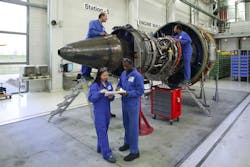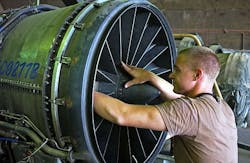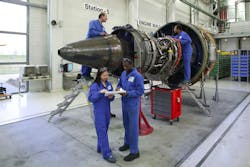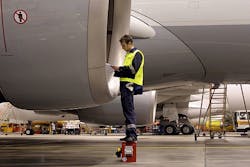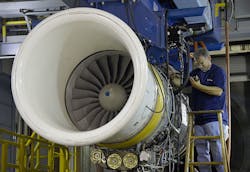Airlines and MRO to benefit from IoT, prescriptive maintenance, augmented reality in 2017
By Kevin Deal, vice president, aerospace & defense at IFS
Civil aviation is one of the most asset-intensive industries in the world. With parts that are high-cost and low in numbers, even the slightest improvements in asset functionality and maintenance can yield significant cost and efficiency advantages. Two of the hottest and much-discussed technologies – the Internet of Things (IoT) and augmented reality – will develop dramatically during 2017 and start to unlock real benefits for civil aviation companies, including airlines and maintenance, repair, and overhaul (MRO) facilities.
Three trends to watch in 2017
1. IoT driving take up of AHMS health checks and condition-based maintenance
Giving fleets a healthy check-up
The civil aviation industry is booming. Aircraft fleets are set to triple by 2034 in the Asia-Pacific region, superseding both North America and Europe, while carriers in the Middle East had the strongest annual traffic growth in 2015. The Internet of Things (IoT) market is following this trend: Gartner predicts over 20 billion connected ‘things’ will be in use by 2020, with total spending topping $3 trillion globally.
Together civil aviation and IoT will drive the use of the Aircraft Health Monitoring System (AHMS) in 2017. AHMS brings vast improvements in the utilization and analysis of big data to enhance availability, reliability and safety of aircraft, which in turn drives the take up of condition-based maintenance (CBM) projects to streamline maintenance, repair, and overhaul (MRO). An Oliver Wyman MRO survey reported that 63 percent of respondents from leading airlines said AHMS increased reliability, with 35 percent also saying that it helped reduce maintenance costs.
The collection and analysis of data from IoT-enabled sensors constantly measuring aircraft health and performance can consider factors such as speed, torque, vibrations, and pressure data to pinpoint faults before they become a major problem and provide actionable information to make better informed and more focused maintenance decisions. These, in turn, could reduce cancellations, improve operational and flight safety, reduce fuel consumption, help identify rogue serial numbers, and enhance both passenger and crew experience.
The Internet of Flying Things
To put this into context, the number of detectable faults on a Boeing 767 in the 1980s was 9,000. Now, intelligent sensors on a Boeing 787 can detect 45,000 faults, five times as many as 30 years ago. With AHMS, data from one aircraft detecting a fault can be used to analyze an entire fleet for the same problem.
The return on investment (ROI) from AHMS in civil aviation is plain to see. The streamlining of maintenance operations and the almost instant reactions to faults that AHMS brings could drastically reduce the chance of aircraft on ground (AOG) for airlines – the cost of which ranges between $10,000 and $150,000 for just a couple hours of downtime. This is a major benefit as most airlines need every possible piece of revenue from every single flight just to stay out of the red.
I predict we will see a rise in the number of operators adopting AHMS, driven by affordable IoT-enabled sensors, powerful data processing systems, and machine learning – enabling airlines to make processes smarter and maintenance leaner.
2. The next step: Not just predicting maintenance, but prescribing the solution
Predictive maintenance: handing engineers the crystal ball
Global MRO spend is anticipated to increase 46 percent by 2026, driven by a combination of growing passenger numbers and aircraft fleets. Because of this, airlines are looking at the next step in asset management, from condition-based maintenance to predictive maintenance, able to detect early signs of potential failure and rectify matters before it impacts service delivery.
Picking out the relevant data patterns being fed back out of the myriad information produced through IoT-enabled parts will allow the true benefit of scheduled maintenance to be extended into every aspect of the MRO support chain.
IoT and predictive maintenance allows for better sharing of both operational and maintenance experiences between airlines, aircraft operators, and third-party MROs, enabling further cost reductions. By feeding the data into the executive aircraft maintenance (EAM) or MRO solution, the parts can be sourced and the work schedules of engineers optimized – meaning potential down-time can be drastically reduced. But airlines aren’t stopping there.
Giving maintenance a healthy prescription
Prescriptive maintenance is the next step beyond simply predicting the status of an asset. While predictive analytics answer the “what will happen, when, and why,” prescriptive goes one step further, allowing operators to not only predict what will happen, but offer “what if” scenarios to show how each possible event will impact operations.
IoT data is fed back from the sensor into the analytical system to optimally define the prescribed maintenance activities based on the best outcome, in terms of reliability and asset uptime. The main benefit is allowing airlines to know what they could do better in the future – if they know an asset may fail, they want to know the most efficient way to reduce the failure rate while also achieving the most effective accomplishment of any rectification actions. Prescriptive analytics can guide maintenance engineers, with sequences of tasks to execute in order to isolate the issue, when is the right time to do the repair and the correct tools to use, helping reduce aircraft downtime.
Prescriptive maintenance will revolutionize MRO. IDC predicts that 50 percent of all business analytics software will incorporate prescriptive capabilities by 2020. In the future, it won’t be a bunch of engineers telling you how and when to repair an asset because the asset itself will tell you what it needs and how it needs it. The technology is still in the early stages of adoption in civil aviation, but watch this space as the technology starts to mature in 2017.
Aerospace businesses embrace big data, IoT, analytics
to enhance and optimize aerospace and defense technologies and tasks, practices and procedures:
http://www.intelligent-aerospace.com/_search?q=internet+of+things&x=0&y=0
3. Resource shortages hindering growth in Asia-Pacific
The demand is there, but is the support?
Airbus forecasts a need for over 33,000 new aircraft globally by 2035, largely driven by the rising demand in the Asia-Pacific. However, this rapid expansion has the potential to be hindered due to a lack of MRO capacity, lack of indigenous training capabilities, and lack of skilled workforce in the region. More passengers mean more planes needed to carry them – more planes mean more maintenance.
Currently, not enough fully qualified, trained, and certified maintenance personnel are available to meet the needs of this growing market. Boeing predicts that the aviation industry will need over 600,000 new maintenance technicians globally in the next 20 years as current personnel retire, with much of this demand coming from Asia-Pacific.
Meeting this demand and matching the requirements of the next generation of maintenance workers will take innovative solutions, including new technologies and training methods.
AR/VR preparing the worker of the future
Experienced aircraft engineers are proving to be few and far between. It currently takes up to eight years for a maintenance worker to pass stringent training tests and become fully licensed, time that the aviation industry cannot wait. Airlines and MRO operators in Asia-Pacific have avoided this by hiring in personnel from other countries, but this is proving to be a significant cost challenge.
Augmented reality – a cost- and time-friendly solution which provides expertise on demand from any location, no matter how remote – is emerging to help bridge this gap. Companies such as XMReality have developed a telepresence and data transmission solution that connects onsite operators with a technical expert anywhere in the world, in real time, giving maintenance workers in remote locations access to a virtual pair of expert eyes and hands to guide them through complex tasks.
I expect we will see a sharp increase in adoption in Asia-Pacific as the technology fully matures to plug this resource shortage gap.
Riding the technology wave
New technologies and the digitization of services are creating big benefits for airline and MRO operators to streamline maintenance, reduce operating costs, and take full advantage of the skyrocketing air travel demand. Early adopters of these three trends will see operations completely transformed. Watch for these technologies in 2017.
Search the Aerospace & Defense Buyer's Guide
The go-to resource for Intelligent Aerospace technology news & information:
Covering key topics
Across all market segments
Subscribe to the free Intelligent Inbox e-newsletter
Subscribe to receive all the latest aerospace technology news & information, delivered directly to your e-mail inbox twice a week (Tuesdays and Thursdays). Sign upfor your free subscription to the Intelligent Inbox e-newsletter at http://www.intelligent-aerospace.com/subscribe.html.
Connect on social media
Keep pace with aerospace innovation and opportunities via your favorite social media channels. Connect with Intelligent Aerospace on Twitter (@IntelligentAero), LinkedIn,Google+, and Instagram.
